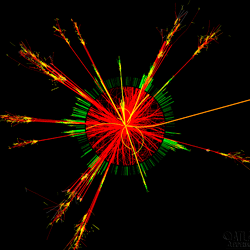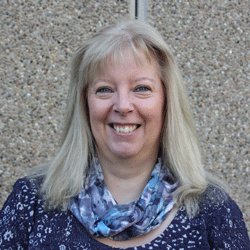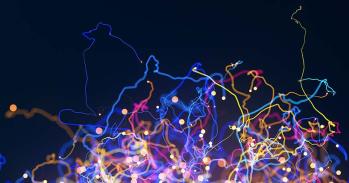
The Large Hadron Collider is being brought back to life, ready for Run II of the “world’s greatest physics experiment”. Cambridge physicists are among the army who keep it alive.
The Large Hadron Collider is being brought back to life, ready for Run II of the “world’s greatest physics experiment”. Cambridge physicists are among the army who keep it alive.
I just want to see what nature has prepared for us, whether that’s consistent with some current theory or whether it’s something else that no one has ever thought about yet, outside of current knowledge
Jordi Garra Ticó
While it slept, we were allowed into the tunnels.
The Large Hadron Collider (LHC) had shut down for two years to upgrade following the discovery of the Higgs boson. In the main ring, 175 m underground, chunks had been cut out of the snaking tubes for essential maintenance. These tubes fire protons in opposite directions, whipping them ever faster until they almost reach the speed of light. Along the 27 km run are four ‘experiments’: vast machines envelop the points at which tubes intersect and particles collide to capture the results. The largest of these, ATLAS, is the size of a six-storey building.
Each collision, known as an ‘event’, produces a splurge of elementary particles such as quarks, gluons and – as we now know – Higgs bosons. On average, events occur 40 million times a second in the LHC.
The precision required for these events is exquisite. Our guide tells us to imagine two people standing six miles apart and each simultaneously firing a gun so that the bullets meet exactly head-on. Except instead of bullets, imagine needles. Inside the tunnels, engineers zip past on bicycles – the best way to get around underground unless you’re a proton. Next to every lift shaft is a bike rack.
In the next few months, the LHC will be switched back on. The 2012 triumph of demonstrating the Higgs boson affirmed the Standard Model: the elegant solution to the building blocks of the Universe. Now, with an anticipated almost doubling of energy for the LHC’s second run, physicists are aiming to “go beyond” the Standard Model.
One of the central goals is to prove or disprove the theory of supersymmetry: the “prime candidate” theory for unlocking the mystery of the dark matter in our Universe.
“Observable matter only makes up 5% of the Universe; the rest is what we call dark matter. We know it’s there because we can see galaxies rotating at velocities which require surrounding matter for such gravitational pull – but, unlike the part of the galaxies that we can see, we cannot detect it optically,” said Professor Val Gibson, Head of the Cambridge High Energy Physics (HEP) group.
Supersymmetry theory essentially predicts that every particle in the Standard Model has a matching particle waiting to be found. These partner particles (or ‘sparticles’) could be candidates for dark matter, but we haven’t yet seen them – perhaps because they are heavier and take more energy to generate, a problem LHC Run II could overcome.
“Supersymmetry theory predicts there is a sister particle of the electron called a ‘selectron’, which would have integer ‘spin’: its intrinsic angular momentum. For the quark, there would be a supersymmetric ‘squark’, and so on for every elementary particle we know,” said Gibson. If supersymmetry is correct, there would also be a further four Higgs bosons for us to discover.

“Proton collisions in the LHC might produce a heavy supersymmetric particle which decays into its lightest form, a light neutral particle, but different from those we know about in the Standard Model,” said Gibson.
“We have been looking for supersymmetry particles throughout the first run of the LHC, and the increase in power for Run II means we can look at higher energies, higher mass, and gradually blot out more areas of the map in which supersymmetrical particles could be hiding.”
Will supersymmetry be proved by the end of next year, or will the data show it’s a red herring? For HEP research associate Dr Jordi Garra Ticó, what is really fundamental is experimental evidence. “I just want to see what nature has prepared for us, whether that’s consistent with some current theory or whether it’s something else that no one has ever thought about yet, outside of current knowledge.”
The two experiments that Cambridge researchers work on are the mighty ATLAS and the more subtle LHCb – known as LHC ‘Beauty’ – which is Gibson and Garra Ticó’s focus. Beauty complements the power of ATLAS, allowing scientists to ‘creep up’ on new physics by capturing rare particle decays that happen every 100 million events.
Garra Ticó spent six months in Cambridge before taking up residence at CERN, where he works on LHCb. LHCb’s 10 million events a second create 35 kbyte of data each, a figure that is expected to go up to 60 kbyte during Run II – too much to ever imagine storing. “There is no guidebook,” he explained. “These machines are prototypes of themselves.”
ATLAS, the biggest experiment, feels like the lair of a colossal hibernating robot. Engineers perch in the crevices of the giant machine, tinkering away like tiny cleaner birds removing parasites. And sealed in the heart of this monster is layer upon layer of the most intricate electronics ever devised.
Dr Dave Robinson arrived in CERN as a PhD student in 1985, and joined the Cambridge HEP group in 1993. He went back to CERN in 2004 – expecting a stint of “one to two years” – and has remained. He is now Project Leader for the most critical detector system within ATLAS, the Inner Detector, which includes the ‘semi-conductor tracker’ (SCT), partially built
in Cambridge.
Each collision event inside ATLAS leaves an impression on the layers of silicon that make up the SCT like an onion skin – enabling scientists to reconstruct the trajectory of particles in the events. “The sensitivity of the tracker is vital for making precise measurements of the thousands of particles generated by the head-on collisions between protons, including decay products from particles like b-quarks which only exist for picoseconds after the collision,” said Robinson.
He is currently working with Gibson and colleagues at the Cavendish Laboratory on the next generation of radiation-proof silicon technology in preparation for the LHC shutdown of 2020, the next time they will be able to get at the SCT, which is otherwise permanently locked in the core of ATLAS. The technology will have an impact on areas like satellite telecommunications, where cheaper, radiation-hardened electronics could have a huge effect.
This, for Gibson, is the way science works: solving technical problems to reveal nature’s hidden secrets, and then seeing the wider applications. She recalls being in CERN when she was a postdoc in the 1980s at the same time as Tim Berners-Lee, who was working on computer-sharing software to solve the anticipated data deluge from LHC-precursor UA1. He ended up calling it the World Wide Web.
Inset image – top: representation of the Higgs Boson particle; Credit: CERN.
Inset image – bottom: Professor Val Gibson.
The text in this work is licensed under a Creative Commons Licence. If you use this content on your site please link back to this page. For image rights, please see the credits associated with each individual image.





